This chapter concerns itself with the hike to Tzfat, one of the four holy cities of Israel.
I woke up the next morning at 6:30am, the designated wakeup time for most days. As it turned out, I didn't have to, since Gill and I were the first people to arrive at breakfast, by far. I suspect the wakeup times were padded so as to account for the so-called "Jewish standard time", a joke which I've never really understood. I was raised to be punctual, and it's a fairly harmless habit so I've never bothered breaking it.
On my way to breakfast I pulled out the camera.
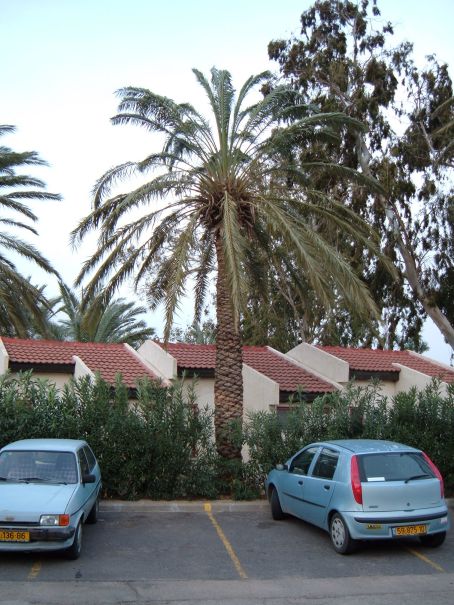
A plant not native to Canada. I took this picture to prove that I'm not faking this whole thing.
I don't know if it's just at the tourist destinations or if it's a typical Israeli thing, but almost every breakfast I had in Israel was exactly the same. I'll describe it here, and then you can assume I had exactly the same stuff on the other days unless I say otherwise.
I had scrambled eggs, tomato, orange slices, cheese, and an almost prodigious amount of cottage cheese. Sometimes I threw in yogurt as well. Everyone else was making comments about how cottage cheese is bland but good for you. Frankly, I don't find it bland at all. I love cottage cheese.
The placemats in the Ein Gev dining hall were interesting. They had a list of vocabulary in Hebrew, English, French, German, Italian, and Spanish. It was pretty neat.
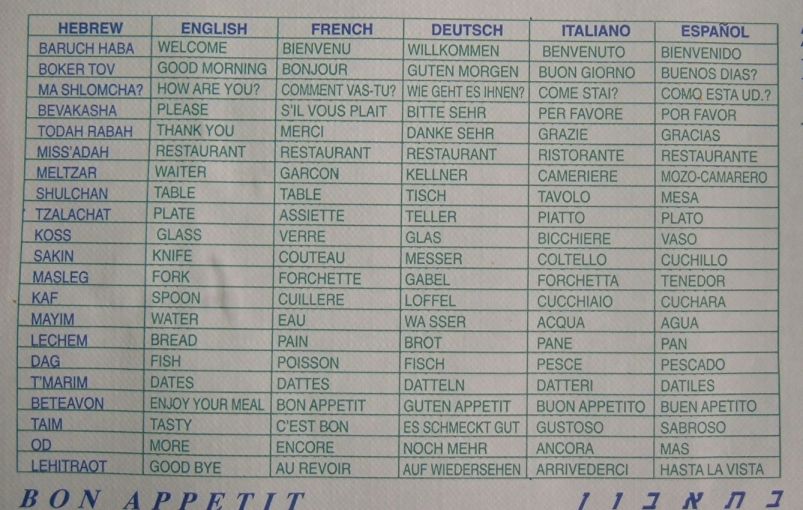
Do the polyglots among you notice anything interesting about the "How are you?" row?
After breakfast we piled onto the bus and headed towards our first hike of the trip. I wrote this on the bus.
Marie - Feb. 18, 8:16am
Okay, I didn't say much about Marie last time, except that she's nuts.
She comes from a very academic family and thus has chosen to rebel by not going to university. Instead, she has chosen to join the navy and become a submariner. Two years at a time in a large, phallic-shaped vessel with a bunch of men. Yeah. Right up her alley, considering yesterday I had to endure a conversation about how she'd like to have sex some three or four times per night. I suggested that we should forget about gay marriage and concentrate on legalizing polyandry.
So, this is the person with whom I've been spending most of my time. Infer what you will.
Our first hike was to be from the foot of the Golan Heights to Tzfat, one of the four so-called holy cities, which was built on top of a mountain because, I can only assume, its builders were sadistic sons of bitches.
For some reason I took several pictures of people right next to the bus.
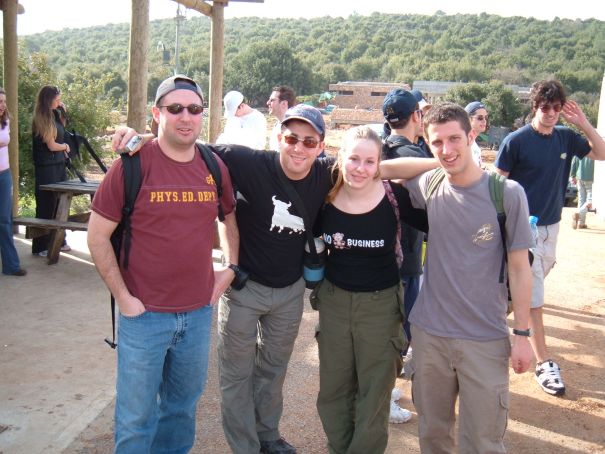
More faces to put to names. Gill, Josh, Marie, and Noah. I haven't mentioned Noah yet.

Esther, me, and Lisa. I really have to work on my fake camera smile. It's so goofy.
The hike was, well, a hike. You know how hikes are. Lots of walking, up and down and around. For the sake of brevity, I won't describe the exact nature of the terrain we were hiking over. But I could.
The first stop on the way was at an ancient guardhouse of some kind. For the life of me, I can't remember its significance, but it was pretty cool-looking. Here it is.

The guardhouse.
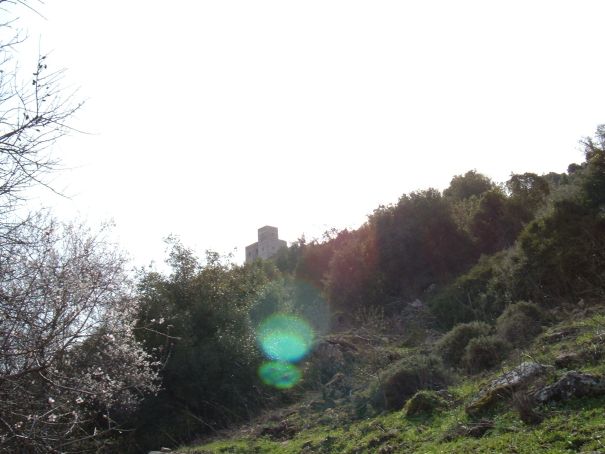
The guardhouse from below. The lens flare is intentional. I was experimenting with exposure settings again.
Our next stop was at a freshwater stream. That might have been what the guardhouse was protecting. I can't remember. Anyway, we drank from it and then moved on. For some reason we don't drink much from streams in Canada. Or maybe I just think that's the case because I grew up in Toronto.
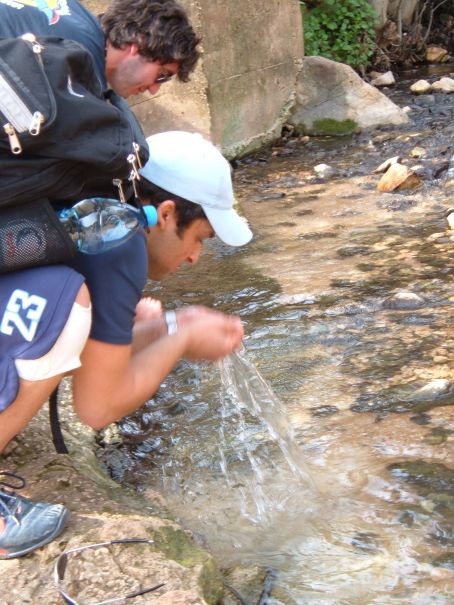
A freshwater stream. I keep saying "freshwater" because in Israel, it's significant.
Next, we stopped briefly and learned about flower mills, of which there were several in the area. I can't remember what the purpose of milling flowers is, but it wasn't that interesting anyway. [Editor's note: It has been brought to my attention that it was probably a flour mill and that I'm a total moron. Thank you.] While we were standing on the roof of one of the mills we took a group photo. Or rather, thirty group photos, since everyone wanted one on their camera. Yuval and the Israeli medic and guard, whom I have failed to mention thus far but who become important later on, took the pictures.
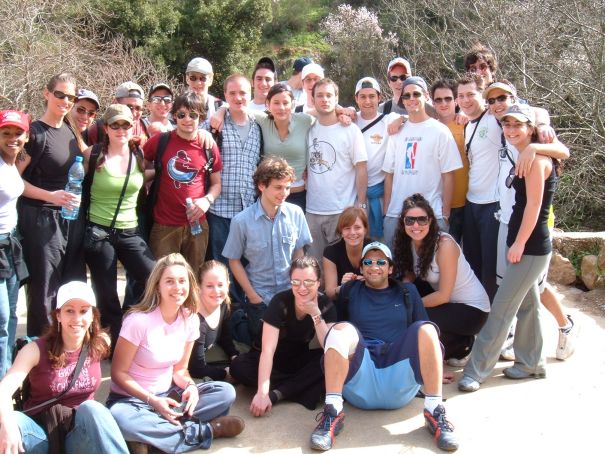
When three people take the same photo on thirty different cameras, you can be sure that some of the photos will not be carefully framed.
We trekked on to our next stop, at the foot of the mountain. You see, we had hiked over one mountain, only to get us to the point from which we could start our hike up the mountain upon which rests Tzfat. Needless to say, it was quite an inefficient way to get there. But it wasn't a total waste, you see, because there was a small pond in which we frolicked for a while.
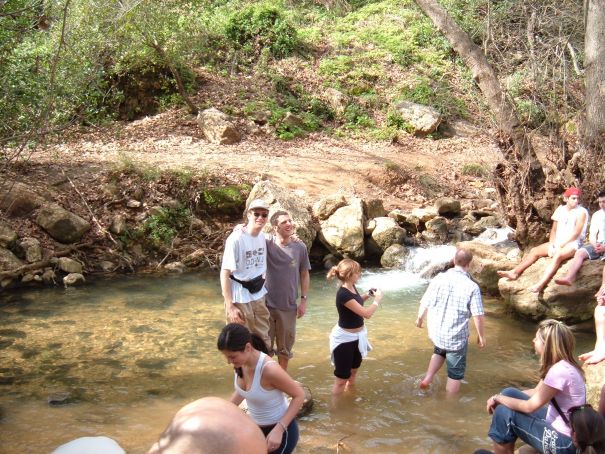
Me and Noah in the pond. I really should have had the person who took this picture zoom in so as to avoid capturing the top of Yuval's head.
After everyone had finished frolicking, Yuval did two unexpected things. First, he pulled out a flute and began playing. Second, he told a bizarre story about the shape of some leaves from a nearby tree, involving a beautiful hermaphrodite princess. I am still not sure whether he was making it up, or whether that's a real Israeli fable.

Do you think I'm including too many photos here?
The hike up the bulk of the mountain was relatively uneventful, although Yuval did stop to point out a bumper sticker that someone had stuck on a sign near the top. It said, basically, that if someone comes to take you out of your home, it's okay to kill him, referring to a potential evacuation of Jews from the West Bank and the Gaza strip. Yuval said that the sticker was bad because it encourages Jews killing other Jews. Personally, I don't see how Jews killing Jews is any worse than Jews killing Arabs or vice versa, but let's not get into that right now.
We stopped to rest when we reached a relative plateau, fairly close to the top. There the Israeli guard showed the proper way to carry wounded comrades in case you should ever have to, which hopefully none of us ever will. Esther volunteered to be carried but then retracted her statement when she saw the technique demonstrated and realized that it might be uncomfortable. I mention that to give you some sense of her character.
The hike continued after some outdoor urination, and eventually we could see the city.

Tzfat. All the really old sites in Israel are this beige colour. It's pretty bland. Check out that pretty blue sky, though.
We continued walking and eventually stopped at a cemetery below the city, where Yuval told another parable. This one wasn't so disturbing. It involved some Rabbis standing on each other's shoulders and trying to pull down heaven, and the moral of story was that everyone should try to fix the world. There was a cool-sounding Hebrew phrase meaning "fix the world", but I can't remember it now. Maybe "tikkun olam" or something like that. Anyway, I don't know if I was the only one who thought this, but it seemed to me that standing on someone's shoulders and trying to pull down a place which is certainly not physically upwards and probably doesn't exist at all doesn't really help anyone. How does that fix the world?
Yuval also told us about the four holy cities, of which Tzfat is one, and how they correspond to the four elements earth, fire, air, and water. I can't remember which cities were which, except that Tzfat was air. The area is not quite geologically stable, and the mystical explanation for the occasional earthquakes is that Jerusalem is jealous of Tzfat's position as the air city, since it's the most spiritual, so it sends earthquakes Tzfat's way.
These stories prompted my next rant.
Stories - Feb. 18, 2:57pm
I suppose most tourists get a kick out of the wacky stories of acrobatic rabbis and anthropomorphic cities, but I do not. These parables don't do anything for me but remind me of how divorced I am from my supposed Jewish roots. I found it supremely ironic that the moral of the story of the rabbi totem pole was that we should constantly be trying to fix the world, since in my opinion religion, in most forms, is one of the chief reasons why it's broken in the first place.
We passed through the cemetery and up about a million stairs to the foot of yet more stairs. Due to an illusion of perspective, there didn't seem to be that many of them, but holy cow, they just went on forever. I'm pretty sure that's the suckers' entrance to the city. The natives probably laugh at the stupid tourists who hike up all the stairs. The mountain hike wasn't too bad; it was almost refreshing, in a way. But those stairs. Deadly.
The first thing we did upon arrival in Tzfat was to eat lunch, where I had my first opportunity to use up some shekels. A bunch of us went to a restaurant and had our first shawarma. For the uninitiated, shawarma is thin strips of meat and various other things in a pita. It seemed good at the time, but in retrospect it was probably the worst shawarma I had on the trip, and I had a significant number of them.
After lunch we did a small amount of touring, including seeing some buildings riddled with bullet holes from the war of independence some half a century ago. I wish I had taken a picture of them. We also visited some synagogues but they were all closed by the time we got there, so we couldn't go inside.
We then did a little shopping. I am no fan of that activity, so I just killed the time doing nothing. Other people bought hookahs. That became the theme of the entire trip. I never really saw the attraction of inhaling toxic gases through a strange-looking machine that looks like something out of science fiction, but maybe I'm crazy. While people were doing this, I took a couple of pictures.
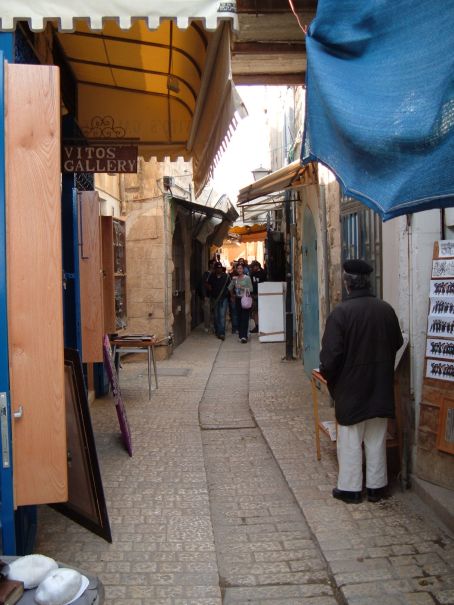
A narrow market street in Tzfat. Pretty traditional-looking, eh?

Not so traditional-looking. This photo was taken from the exact same spot, just facing the other direction.
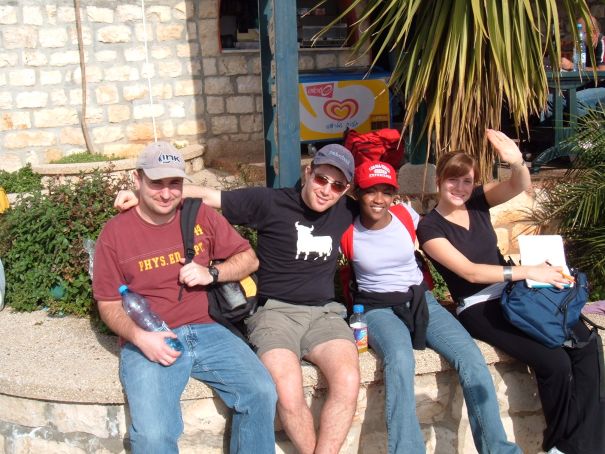
Gill, Josh, Leah, and Jesse is the lovely lady doing the "heil", or possibly just blocking the sun. She looks much better without the shadow of a hand across her face.
We then left Tzfat and headed back to Ein Gev to prepare for Shabbat.
Chapter Four













